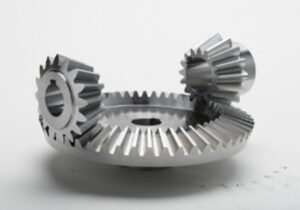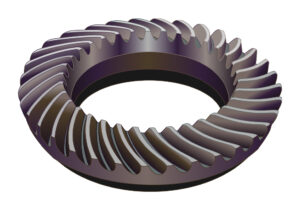
In the vast domain of mechanical engineering, gears play an important role in transmitting power and motion between rotating shafts. Among the myriad types of gears, one that stands out for its unique design and versatility is the bevel gear. In this article, we will be unfolding the world of bevel gears, exploring their definition, efficiency, various types, manufacturing processes, and applications, and ultimately, concluding their significance in engineering.
Continue reading…!
Bevel gears are a special class of gears that transmit motion between intersecting shafts, typically at right angles. Unlike spur gears, which transfer power parallelly, bevel gears have conical shapes, allowing them to redirect rotational motion around corners with precision. The defining characteristic of bevel gears is their conical-toothed surfaces, which come in two main varieties: straight bevel gears and spiral bevel gears.
One of the critical aspects of any gear system is its efficiency, and bevel gears are no exception. The efficiency of bevel gears is influenced by factors such as tooth design, lubrication, and alignment. Proper tooth geometry is essential for minimizing friction and wear, while adequate lubrication ensures smooth operation and reduces heat generation. Additionally, precise alignment of bevel gears is crucial to prevent misalignment-induced losses. Despite inherent complexities, well-designed and properly maintained bevel gears can achieve high levels of efficiency.

Straight Bevel Gears:
Straight bevel gears have straight conical teeth and tapering towards the apex. They are commonly used in applications where simplicity and cost-effectiveness are priorities. However, due to the nature of their tooth engagement, straight bevel gears may produce more noise and vibration compared to other types.
Spiral Bevel Gears:
Spiral bevel gears, on the other hand, feature curved teeth that gradually spiral around the gear’s surface. This design enhances the smoothness of motion and reduces noise and vibration, making them suitable for applications demanding precision and quieter operation. Spiral bevel gears are often preferred in high-performance systems such as automotive differentials.

The manufacturing of bevel gears involves precision machining and careful consideration of gear geometry. Common processes include milling, shaping, and lapping. Modern manufacturing techniques, such as CNC machining, have significantly improved the accuracy and consistency of bevel gear manufacturing and production.
Bevel gears find applications across various industries due to their ability to transmit power at right angles efficiently. Some notable applications include:
Therefore, bevel gears play a pivotal role in diverse mechanical applications, thanks to their unique design and ability to transmit power at right angles. Understanding the efficiency factors, types, manufacturing processes, and applications of bevel gears is essential for engineers seeking to optimize gear systems for various industries. As technology advances, the continued refinement of bevel gear designs and manufacturing processes will contribute to their enduring significance in the world of mechanical engineering.